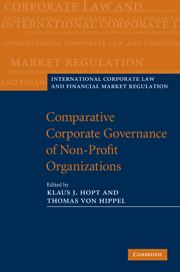Book contents
- Frontmatter
- Contents
- List of contributors
- Preface
- Abbreviations
- PART I Economic findings and theories on nonprofit organizations
- PART II The nonprofit sector: private law, trust law, tax law in selected countries
- PART III The board of nonprofit organizations
- PART IV Good governance of nonprofit organizations: activities and regulatory problems
- 10 Fundraising
- 11 Asset management in nonprofit organizations
- 12 Nonprofit organizations and economic activities/enterprises
- 12.1 Nonprofit organizations and economic activities/enterprises
- 12.2 Nonprofit organizations and enterprises: the Danish foundation law as an example
- 12.3 The protection of members and creditors of nonprofit organisations
- PART V Good governance of nonprofit organizations: self-regulation, disclosure and supervision
- Index
- References
12.1 - Nonprofit organizations and economic activities/enterprises
from 12 - Nonprofit organizations and economic activities/enterprises
Published online by Cambridge University Press: 05 August 2011
- Frontmatter
- Contents
- List of contributors
- Preface
- Abbreviations
- PART I Economic findings and theories on nonprofit organizations
- PART II The nonprofit sector: private law, trust law, tax law in selected countries
- PART III The board of nonprofit organizations
- PART IV Good governance of nonprofit organizations: activities and regulatory problems
- 10 Fundraising
- 11 Asset management in nonprofit organizations
- 12 Nonprofit organizations and economic activities/enterprises
- 12.1 Nonprofit organizations and economic activities/enterprises
- 12.2 Nonprofit organizations and enterprises: the Danish foundation law as an example
- 12.3 The protection of members and creditors of nonprofit organisations
- PART V Good governance of nonprofit organizations: self-regulation, disclosure and supervision
- Index
- References
Summary
General background
In a document headed “About the Conference”, my task is described as giving an account of nonprofit organizations and economic activities from the perspective of a European country. As a Swedish legal scholar, I will give an account of Swedish solutions to the questions I have been asked to discuss. It could be added that the solutions that we find in the law of Sweden are sometimes exclusively Swedish, but quite often the laws of Denmark, Finland, Iceland, Norway and Sweden have developed along similar lines. These five Nordic countries have to a high degree a common history – we have a fairly similar culture, educated men and women at least can read texts written in our different languages, with the exception of Finnish and Icelandic, and we often meet to discuss common topics, including topics of a legal nature. The following account, though, is concerned with Swedish law, even when I do not use the adjective “Swedish”.
A nonprofit organization may be understood either as an organization that does not do business, and therefore has no business profit to distribute, or as an organization that might be involved in business activities, but is not allowed to pass on the results of its activities to particular individuals inside – or outside – the organization. That these two ways of looking at the term “nonprofit” have not always been distinguished in debates about what should and should not be permitted is made clear by discussions in different forums in different parts of the world.
- Type
- Chapter
- Information
- Comparative Corporate Governance of Non-Profit Organizations , pp. 740 - 769Publisher: Cambridge University PressPrint publication year: 2010



